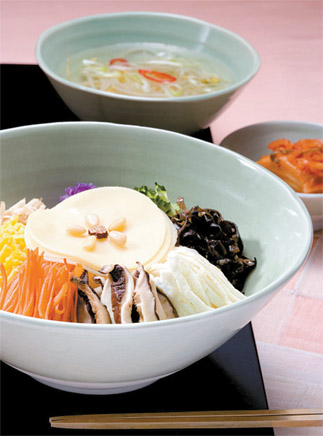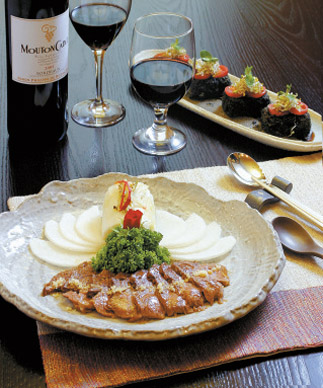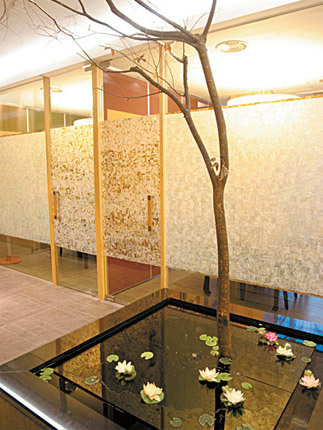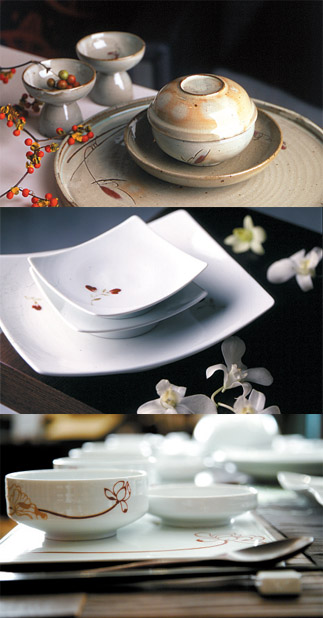Rice and veg for a new generation

A bibimbap main dish at Cafe Sobahn, central Seoul.
Diners tend to want something different, and with well-being still a craze these days, restaurants are presenting selected traditional foods in a way even the most trendy of food aficionados can appreciate.
At Cafe Sobahn Rice & Mix (www.sobahn.co.kr) in Gwanghwamun, bibimbap, mixed rice and vegetables, gets a makeover.
“We decided on bibimbap because it’s one of the most representative Korean dishes and uses natural ingredients,” explained Kwon Hyung-jun of CJ Foodville, which owns the cafe.

A beef and white cabbage kimchi dish.
The idea is to eliminate the frenetic atmosphere prevalent at most Korean restaurants, he said.
Who’s the target customer? The working man or woman?
“The Korean food industry tends to focus on the needs of the working female population. Most men here are not fussed about enjoying a unique dining experience,” said Kwon.

The interior of Soban, Yeoksam-dong
“Sales have increased by roughly 10 percent a year, with the biggest sales increase of 20 percent last year,” said Won Yong-hun, the manager of the Gwanghwamun branch. However, I would have to say sales have leveled off this year since other similar restaurants have opened nearby.”
A cafe with a similar name, Soban, (www.soban.co.kr) also serves variations of traditional Korean dishes. The manager, Kim Dong-chul, said Soban tries to break ties with the past. You won’t find any spicy stews or exotic flavors at Soban, which is in Yeoksam-dong, southern Seoul.

The serving counter at Cafe Sobahn. Provided by Soban; CJ Foodville
“We don’t serve fusion but a selected choice of healthy Korean dishes. Since the health and well-being of our customers are a priority, we even try to limit the use of salt and different sauces. This might cause some first-time diners to think our dishes are bland,” Kim said.
Soban’s popularity is impressive. Kim said sales figures have increased by nearly 20 percent since the restaurant opened in December 2005 and total annual sales have more than tripled since 2006.
The rise of trendy health-conscious Korean restaurants does not mean traditional motif restaurants are on their way out. One of the more interesting places to try out is Seokparang (http://seokparang.co.kr) where you can sample traditional royal cuisine. The building dates back to the late-Joseon era and features a combination of Korean and Chinese architecture.

Top to bottom: Traditional ceramics designed with a more contemporary look. Provided by KwangJuYo
“After the popularity of the Korean TV drama ‘Dae Jang Geum (A Jewel in the Palace),’ many visitors from overseas have visited our restaurant,” said Ho Kyung-wook, the manager. “Seokparang is a great place to experience traditional Korean culture and history together as one.”
The menu consists of dishes made from fresh seasonal ingredients. The set menus consists of neobiani (grilled beef), songitang (pine mushroom stew) and sinseollo (cooked rice mixed with assorted ingredients).
You won’t find these dishes in the average restaurant on the street.
If you want to know about food made from fresh seasonal ingredients in Korea, you should check out temple food eaten by Buddhist monks. Their diet shuns artificial additives and strong flavored ingredients such as onions, garlic and Korean leeks.
“Temple food helps maintain a sound mind and body,” said Jeok Moon, a Buddhist monk at the Korean Traditional Temple Food Institute. Jeok Moon said a growing interest in meditation, temple stays and temple food indicates that many people want to change their hectic lifestyles.
“Although the popularity of temple food increased in Japan during the 1960s, the interest in temple food here in Korea started in the 1990s. There are even temple food restaurants in Manhattan, which shows that interest in this diet is global, not just domestic,” Jeok Moon said.
A more surprising sight of late has been tteok, or rice cakes, at cafes and coffee shops. While a mainstay at major celebrations and holidays, rice cakes were not exactly hot items until recently.
But Starbucks Korea has announced a new line. “Rice cakes are low-calorie and have nutritional value,” said Park Han-jo of Starbucks Korea. So next time you head into a Starbucks, look out for tteok in strawberry, sagebrush, pumpkin, green tea and black raspberry flavors.
They could make for a healthy alternative to a double chocolate muffin.
By Jason Kim Staff Reporter [jason@joongang.co.kr]










with the Korea JoongAng Daily
To write comments, please log in to one of the accounts.
Standards Board Policy (0/250자)